Clusters of insights - quick access
- What we do in public and third sector organisations
- How we feel we contribute
- How do designers work in public and third sector
- Motivations for being a designer
- Impact of design on people
What we do in public and third sector organisations
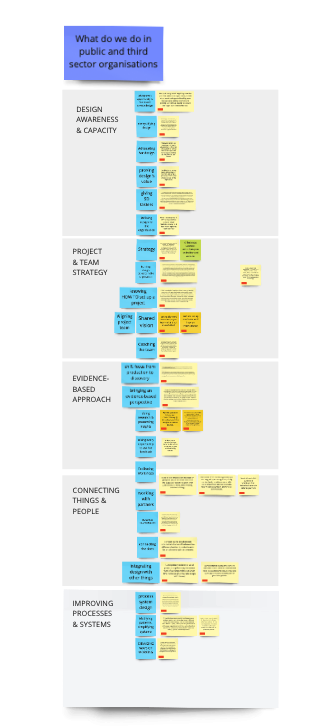
Access the part of the Miro Board represented in the image
List of clusters of insights
Select one of the clusters of insights to see the quotes supporting it. Select it again to hide the quotes.
Design awareness and capacity
Taking every opportunity to talk about service design
- We took pretty much anything over the past few years as an opportunity to talk about service design and making sure that we were getting involved and putting our hand up saying we would like to get our teethes into that
Demystifying design
- Service design is not rocket science, it really instinctual stuff, that's what I'm trying to get across to folks.So you just start with simple question with folks before you do the double diamond and or whatever else, you teach them about user research things, prototype etc, etc...and then that's the thing, demystifying the various things about that
Advocating for design
- What we‘re doing in our team is we are trying to advocate for it. [...] my role is to advocate for why we need to do things in the way we suggest them to do, not just to be user-centred
Proving design's value
- I am bringing my service design skills to that new fieldwork and trying to push and prove the value of service design for the organisation
Giving SD tasters
- [...] a few high-level workshops [were organised], which included the chief executive and a few other key head of service directorate type of people, just to show them what [SD] was like. That lead to [the] chief executive recommending [...] to do a session [... for] about hundred people across the councils from directorate head of service level. [one day session involved] doing that whole double diamond work, walked through a couple of challenges, did some service safari and coming up with some ideas. It was good and led to a short-life project [...] with one of the ideas from the day through three or four months of workshops and developing that idea up. So that was a kind of test of service design
Defining design for the organisation
- What is the meaning of UX? The [organisation] has taken design relatively seriously or at least we are exploring it quite carefully
Project and team strategy
Strategy
- I am heavily moving more and more into strategy [...] in a massive over-bureaucratical organisation. It is different from a consultancy side. But now where I‘m embedded in the organisation it is quite interesting to see how all the research and insights come out of a much bigger strategy piece. Moving into a more holistic way
- Strategy, Insight and Engagement [...], to me those three words mean service design: it takes something from research and insight, synthesis, prototyping, innovation and then it goes into an implementation and strategy
Building design capacity in the organisation
- Internally we've done some work to shift to a more service design knowledge base. People like myself who came from a service design background were applying design thinking tools and methodology (like co-design and participatory design) at work already. But our Learning and Development department didn't rule it out as "this is something you should do". But year, we sent myself and 5 different managers on a service design training to upskill, to lift the bar across [the organisation] in terms of the tools and methods that were available to everyone, the language that people like me were using and make it more readily accessible. By sending 5 different teams on training, we were able to lift the kind of baseline, designers [...] across the organisation could then work with people in a much easier way because they knew the language and the tools. [You] still need to be the facilitator. The tools, methods and workshops are not always the starting point, you need to do meticulous planning, think who the right people are for each project, before you start together. But the fact that everyone knows the language now and everyone knows why we are doing things, why service design or design thinking as an approach, why it's going to be beneficial in the long run, I think it's a really good starting point
Knowing HOW TO set up a project
- It‘s like I have a bank of knowledge of how to scope out a project, set up in the right way, to be inclusive and accessible, how to research, how to analyse things, how to use different methods. [...] So just really trying to set it up in the right way, that allows for maybe some kind of prototype, or at least for insights to be taken into account in various streams of work, and also making data and insights a bit more open throughout the process. So yeah, just really using everything I‘ve learned so far
Aligning project team - Shared vision
- Getting alignment within the project team - what is our shared vision?
- How we set up our team and how we communicate
Coaching the team
- I just coach [the rest of my team] in the way I’ve been coached, from a service design and community perspective, and try to push for those. I think they find that quite refreshing. It’s just a different way of thinking [...] the way I line manage, coach, [and] support my team [...] Listening and learning from them. That empathy to interaction, I guess
Evidence-based approach
Shift focus from production to discovery
- A lot of traditional stakeholders view [new projects] as if you have another contract or another need, - "Can you please design us a tool for [this]? They want to see it as a production task, so here is the brief can you go and make this for us please. [Our response]: "Hold on a second, give me a short and snappy brief about the problem - the challenge the team needs to face - and we are going to: research that problem, talk about who needs to be involved, do discovery before we even touch any of the production side of it. We are going to do that because you're going to have a more impactful, long-lasting solution. The users who are going to use it are going to be involved from the start, it's not just going to be done by a team and once it's ready there going to see it
Bringing an evidence-based perspective
- [A team in the organisation] provides face to face as well as digital services. They tend to manage their own estate, their own knowledge platform or booking system. But they never saw themselves as someone who provided a service.[...] They didn't have that kind of user experience perspective, they were really good at saying this is what we do and why it's good, instead of this is the evidence, this is the kind of feedback we're getting, this is why this service exist..
Doing research & presenting insights
- My role was quite UX and user research heavy. [I] basically present the insights to various boards
- I’m not entirely sure what kind of service design I‘m doing. So, I feel like we are more in the user research sphere. But I am bringing my service design skills to that new fieldwork and trying to push and prove the value of service design for the organisation
taking every opportunity to ask for feedback
- [Taking every] opportunity to get some feedback from colleagues [as] part of that thinking process
Connecting things and people
Facilitating Workshops
- I also do lots of facilitation of people or groups of people and that's either for the purpose of design research or for just collective activity, sense making, that kind of things
- It's kind of 50/50 facilitating workshops, working with partner agencies, doing service design to drive projects with external partners but also internally, how we set up our team and how we communicate
- I probably got a big portfolio of workshops that I helped facilitate with different partners
Building realtionship
- There is this other side of relationship building, because it‘s quite important. [This public sector organisation] has such a different culture of leadership to any other organisation I‘ve ever been in or worked with. Relationship building and those skills from our sphere work, has been extremely useful like the openness, the willingness to share everything that we can
Connecting the dots
- Connecting the dots between service A and service B between two different charities to make it easier for an adviser to talk to someone
Integrating design with other things
- [...one person decided to use a] project as a pilot to try these new ways of working and to use Scrum [it's challenging to integrate design with Scrum]
- [When I started leading the team] we started to look at other lean reviews for the best way forward because they were quite paper heavy and hard work for people to get into
Improving processes and systems
Process system design
- We did a really awesome project about helping [vulnerable users to access a benefit]. We built a robotics process automation linked between data, we brought three systems together, we basically created an algorithm. And I was like, where is the sexy money shot for the website that we made. And [my colleague] was like, there is none. That’s the point, you know, and with that I can’t remember the stats but I think we managed to get like 2000 [more users to access this benefit] .. I don’t know. I’m just like ahhh, there is a real danger there. [ that we can't show the success]
Identifying patterns, simplifying systems
- Things like booking an appointment happens over and over again, every single day in many different places. So if we actually [...] sort out how does that work well for a [user], for staff, for the system so that all three get a good deal out of this, and we back that up with the software we design, [and] the data we need. [...] this is a massive potential
- [when] I took over the team [...] we started to look at other lean reviews for the best way forward because they were quite paper heavy and hard work for people to get into
Changing ways of working
- Working within a third sector organisation, [the members of the team] work with people as well. So I have been able to contribute to some of the work that they have been doing, and change some of the approaches
How we feel we contribute
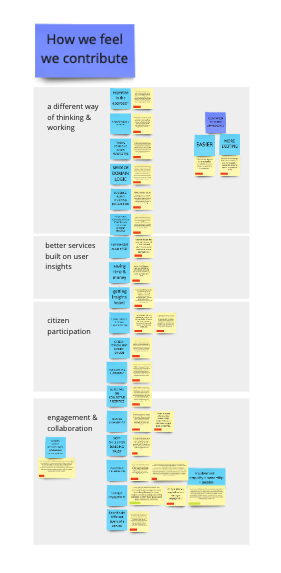
Access the part of the Miro Board represented in the image
List of clusters of insights
Select one of the clusters of insights to see the quotes supporting it. Select it again to hide the quotes.
A different way of thinking and working
Expertise in the approach
- I work with lots of different client - private sector, public sector, some 3rd sector - and the thing that I take with [me] is that service design approach, I don't have any specialist [...] area of expertise. My expertise is coming in and taking them on a different approach, a lot of the clients I work with had never done a design-led approach before
Understanding context
- Potentially, it contributes a lot in terms of understanding the people that public and private sector serve, finding what their needs and aspirations are, figuring out different ways of engaging them creatively
Taking someone else's perspective
- I am going, ‘so, yeah, we could probably like map like how people [use the service]’ but nobody has thought that way. I think that’s what’s really important and I try to remind myself is that I come with a perspective of seeing the world as if others.. I can’t be on anyone’s shoes cause I’m not them, but I come at it thinking that we should think about being on someone else’s shoes. So I think I definitely bring a legitimised way - although some people think it is nonsense and that’s ok - of addressing how we might look at something form someone else’s perspective
Service domain logic
- The other thing that is really important is just helping people recognise that they actually run services. Seeing the world from a kind of service-dominant logic is not always right but then going, ‘that thing that you are doing is not policy is a service’. Whith [the organisation] I have tried to get them to actually map what all of those service are, just so we actually know what we do; and then you can start to really see yourself as a service provider. I think in a lot of public bodies, you get a lot of money and you get annual letters in policy and you have to turn them into like, stuff. It’s a whole lot of business with no one even thinking that they are designing a service. So yeah, I think that what I bring is seeing the world in a service way and then,
Evidence based ongoing interaction
- Helping organisations figure out what a test and learn approach looks like and on an ongoing basis. [...] ‘let’s look at how to be a data-driven organisation, both quantitative and qualitative, maike design decisions based on what we are learning
Creates the opportunity to stop, think and challenge current practice
- I guess it has not touched all public and third sectors, but what it can contribute is it gives people an opportunity to stop and think. It creates the space to challenge what they have been doing so far, And be able to use different tools and have different types of conversations. But they need to be done sustainably I think
Compared to other approaches, it's easier and more exciting
- Because service design is a lot more hands-on, a lot more customer-focused and easier for people to get excited about
- Then we kind of grown it and realised the accessibility of service design compared to the Lean stuff
Better services built on user insights
commercial value of SD
- [Service Design] has a purely commercial context as well; which is, you know, the kind of airbnb approach to it
Saving time & money
- Doing it [the SD] way will make sure this things are more efficient, affected to the service it's meant to be, saving you money and time
Getting insights heard
- Presenting any findings, whether that are blueprints or user journeys, to make change happen or to provoke conversation at senior management level. [...] and for people to listen those recommendations or prototypes or whatever else
Citizen participation
User-centred beyond consultation
- I guess what it does is to recentre everything around the user, And to be honest, this is not just service design but also research And any other discipline within UCD
- It engages people creatively, it is not just about consultation. You know, we’ve all been to town hall consultations, where you just sit there or we look at boards. Someone is trying to explain why this shopping centre is the best thing What can happen to your town. and they don't really wanna know what you think. they just, you know, Ticking the boxes. service design takes us way beyond that
Citizen driven, not money driven
- Instead of saving money, the very core purpose was about what is the citizen need out of the council and how can we design our range of projects that will give citizens benefits, but also benefits to the council either financial or in other ways. So, a lot became about people rather than about process and money
Participative democracy
- Its contribution to the civic sphere is that it engages people. [...] service design is a means to fundamentally [...] about shifting democracy into something that is more participative. [...] A practical approach to participative democracy, that's always where I saw that design had [...] the potential to involve citizens in a participatory way in how the world is constructed and how it serves them
Engagement and collaboration
Building on collective priorities
- People have been so receptive to [our wok] because it is not outcomes-focused. I'm going in there asking them to support our knowledge. It is seen as a collective priority even though people might not have the time to address it. I think they are more receptive because they see that there's someone actually doing something about it or being able to evidence it in a way that is not... in a different kind of way that they usually would
Creative engagement
- It’s an interesting space, I think. Being on projects is interesting to understand the role that you play. Because there is a kind of real flip between Logical, evidence-based, robust kind of thinking and analysis, and also this desire for this creative spark. And normally, that creative spark falls under the service designer
- I think that's the difference that service design makes if it's done well, that it engages people creatively
Soft skills for building trsut
- So being very open about things and the way I‘ve grown up to be a service designer, and my way to communicate. It‘s just extremely useful to develop that trust. [...] They will trust me now and we will create something nice
Facilitating collaboration
- And also a bit of facilitation like of coming together in collaboration. Things don't just happen in isolation. You know, often the service designer is that link between The project manager, and the UR, and the BA... all kind of coming together around essential points. It acts as that focal point, I think
- Most of the problems the 3rd sector tries to address are complex, wicked problems [...]The only way to even just half achieve solving the problem is to work collaboratively with other partners. If on the ground level you take an adviser from [...] who actually goes into people's home to talk [...] about the issues they are having, [...] those advisors, [...] realise that there is a connected education, or social, or poverty problem. They aren't the expert [in everything, so] partnership working is going to be key. [...] we design what these relationships look like, and how they thrive and communicate with each other. I think service design is the kind of glue between the different partners, different agencies
Complex, wicked problems need collaboration across partners
- Most of the problems the 3rd sector tries to address are complex, wicked problems - homelessness , domestic abuse, poverty. [...] They are so moving, even when you start to chip away at the problem, the next year the government, the budget, or a coronavirus comes around. It's a constant moving issue. The only way to even just half achieve solving the problem is to work collaboratively with other partners
Stronger engagement
- Some people were interested and surprised that we‘re doing that kind of work, doing this amount of user research and trying to design something that works for them. Some people were quite enthusiastic about that
- Doing it [the SD] way will mean a stronger engagement
Involvement = empathy + ownership + passion
- The more involved clients and the more involvement you get and then the customers or users or whatever the scenario is, the more they own it, the more passionate they become about it, the more empathy they have. It's much easier to get that kind of knowledge because they are there, whereas the kind of writing a report and play it back, or telling them how something has gone, because they are involved in it
Coordinate different layers of a service
- Service design has this amazing capacity to coordinate all those layers that you have in a service: [the] experience, the staff workflows, and things like [...] safety and modelling of data, and the technology cause [the organisation] uses a lot of technology and software to manage all the data they produce to really understand a person, and coordinate all of the tests and everything
How do designers work in public and third sector
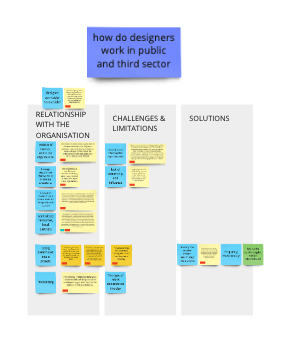
Access the part of the Miro Board represented in the image
List of clusters of insights
Select one of the clusters of insights to see the quotes supporting it. Select it again to hide the quotes.
Relationship with the organisation
Designer as insider vs outsider
- [the advantage of] service design being embedded in these organisations as opposed to being external consultancies is that we can learn and we can develop patterns
Pockets of interest within the organisation
- We‘re kind of alone in the organisation in the sense that we‘re the only team looking at user-centred approaches and service design. [In] the rest of the organisations it‘s like bits and pieces there, little areas of interest
A design department that works as an internal consultancy
- We act a bit like a consultancy or internal consultancy, where we go and try to help other teams in the [organisation]
A devolved model of SD: a central team for design advise & support
- [We] have a mixture of service design and product design and UR meeting every week to talk about the practice the tools and methods we use, how the projects are going, to use each other as a sound board... it all ties in with [...] having a devolved model of doing design. Our new digital framework [builds on] the idea that we need not necessarily designers at every location, but we need the team who provides services to know about design thinking and how to facilitate their own processes in a design-led way. But we need a central team who can advise, provide support, document good practice
Centralised resources, local partners
- There's differences in the Scottish law, in the Scottish Government and the Scottish people. [...] There is a reason for [having a Scottish team as] a separate entity. In a digital sense or a service design sense, we do rely heavily on the core team, the English team, because it's about resources. We only have so many people like me based in Scotland who can provide service design or facilitation at scale.[...] A lot of the projects that we run rely heavily on the collaboration [with teams outside Scotland to do] the research, changing a website or part of the service. I might happily facilitate with Scottish charities, [...] and get some partner agencies involved, or the local government. [...] If you didn't have me in Scotland to facilitate the work and facilitate the process, I guess that's what's different: your partners needs to be local
Being parachuted into a project
- Sometimes you end up being [...] parachuted as a designer to be that good facilitator, [and] sometimes the workshop should not have been the starting point
- For example, I was dropped in [a project] where we had [...] one group saying "I've got money to spend. Let's make things better, but let's make it very quickly", and then other people [saying] "yes, but what's the user need, how do we map this [...] and make a clean design process"
Freelancing
- I'm currently freelancing doing what I would usually call design research; and depending on what day it is, the definition of that is different
Challenges and limitations
Decentralised efforts within organisations?
- There is a team elsewhere in the [organisation], which is lot about developing systems for [users] or [user-data] management systems and things like that and there is a pocket of people there like business analysts, who are really interested in user experience and lean and start talking about service design as well. So, there are pockets like that, pockets of interest. But very separated across the [organisation] as a whole
Lack of ownership and influence
- We don‘t own, we don‘t really look after that many services and we have limited influence over actual services and even limited influence over actual products
The type of work depends on the day
- You realise that the workshop setting should not have happen on that day
Solution
Framing the problem before parachuting into a project - Preparing meticulously
- We should have framed the problem, realise that there was a lot of moving parts and different needs before [being] parachuted into that. Regardless of how good a facilitator you are, it's massively important that, as well as preparing meticulously well in advance, sometimes the timing
Motivations for being a designer
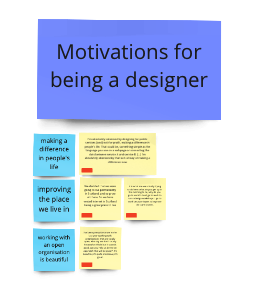
Access the part of the Miro Board represented in the image
List of clusters of insights
Select one of the clusters of insights to see the quotes supporting it. Select it again to hide the quotes.
Making a difference in people's life
- I'm absolutely obsessed by designing for public services [and] not-for-profit, making a difference in people's life. That could be, something simple as the language you use on a webpage or connecting the dots between service A and service B. [...] I'm absolutely obsessed by that sort of way of making a difference now
Improving the place we live in
- We decided that we were going to live permanently in Scotland, and so grow old here. So we have vested interest in Scotland being a great place to live
- It is what are we actually trying to do here: what do you get up in the morning to do, why do you go to work? I don’t go to work to run codesign workshops. I go to work because I want to improve the care system
Working with an open organisation is beautiful
- I’ve been pretty fortunate in the last year working with organisations that are totally open, who say ‘we don't totally know what this is but it sounds good, can you help us devise an approach that will be good?’, it's beautiful, it's quite emotional, it's great
Impact of design on people
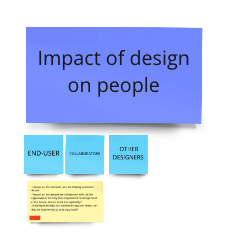
Access the part of the Miro Board represented in the image
One quote:
- impact on the end-user, are we helping someone thrive?
- impact on the people we collaborate with, as the organisation: do they feel empowered to design stuff in the future, did we build the capability?
- [sharing learning] can someone copy our ideas, can they be inspired by us and copy stuff?